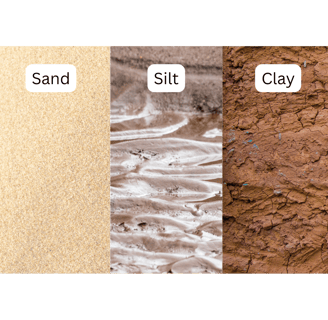
Soil Selection Guide
A plant's health starts from the ground up—literally. Selecting the right soil is crucial for promoting healthy root systems and ensuring your plants thrive. This guide will help you understand different soil types and recommend the best options for various plants.
Soil Selection Guide:
Choosing the Best Soil Types for Healthy Root Systems
A plant's health starts from the ground up—literally. Selecting the right soil is crucial for promoting healthy root systems and ensuring your plants thrive. This guide will help you understand different soil types and recommend the best options for various plants.
Understanding Soil Types
Before diving into specific recommendations, it's essential to understand the basic components of soil:
Sand: Large particles that improve drainage but don't hold nutrients well.
Silt: Medium-sized particles that retain moisture and nutrients better than sand.
Clay: Small particles that hold nutrients and water effectively but may cause poor drainage if too abundant.
Loam: A balanced mixture of sand, silt, and clay, considered ideal for most plants.
Organic Matter: Decomposed plant and animal materials that enrich soil fertility.
Factors Affecting Soil Choice
Drainage: Some plants prefer well-draining soil to prevent root rot, while others need moisture-retentive soil.
Nutrient Content: Soil rich in organic matter provides essential nutrients.
pH Level: Certain plants require acidic or alkaline soils.
Texture: Soil texture affects aeration and root penetration.
Soil Types for Various Plants
1. Succulents and Cacti
Recommended Soil: Fast-draining, sandy or gritty soil.
Description: Use a cactus or succulent mix that contains sand, perlite, or pumice to prevent water retention.
Why: These plants are prone to root rot if kept in moist soil; excellent drainage is crucial.
2. Tropical Houseplants (e.g., Monstera, Philodendron)
Recommended Soil: Rich, well-draining potting mix with organic matter.
Description: A mix containing peat moss or coco coir, perlite, and compost.
Why: These plants need moisture-retentive soil that still allows excess water to drain, preventing soggy roots.
3. Acid-Loving Plants (e.g., Azaleas, Rhododendrons, Blueberries)
Recommended Soil: Acidic soil with a pH between 4.5 and 6.0.
Description: Use soil amended with peat moss, pine needles, or sulfur to lower pH.
Why: Acidic conditions enable these plants to absorb nutrients effectively.
4. Vegetables and Herbs
Recommended Soil: Fertile, loamy soil with good drainage.
Description: A balanced mix of sand, silt, clay, and plenty of organic matter like compost.
Why: Nutrient-rich soil supports vigorous growth and abundant yields.
5. Flowering Plants (e.g., Roses, Geraniums, Petunias)
Recommended Soil: Well-draining soil enriched with organic matter.
Description: Loamy soil mixed with compost or well-rotted manure.
Why: Provides essential nutrients and proper drainage to support blooming.
6. Orchids
Recommended Soil: Specialized orchid mix.
Description: Composed of bark, charcoal, and perlite; lacks traditional soil.
Why: Orchids require excellent air circulation around their roots and do not thrive in standard soil.
7. Ferns
Recommended Soil: Moist, rich soil with good drainage.
Description: A mix of peat moss, compost, and perlite.
Why: Ferns prefer constant moisture but need soil that doesn't become waterlogged.
8. Bonsai Trees
Recommended Soil: Fast-draining soil with adequate moisture retention.
Description: A blend of akadama (clay granulate), pumice, and lava rock.
Why: Supports fine root development and prevents root rot.
9. Carnivorous Plants (e.g., Venus Flytrap, Pitcher Plants)
Recommended Soil: Nutrient-poor, acidic soil.
Description: A mix of sphagnum peat moss and sand or perlite, without fertilizers.
Why: These plants are adapted to nutrient-poor soils and obtain nutrients from captured insects.
10. Bulbous Plants (e.g., Tulips, Daffodils)
Recommended Soil: Well-draining soil with moderate fertility.
Description: Sandy loam soil enriched with compost.
Why: Prevents bulbs from rotting and supports healthy growth.
Tips for Improving Soil Quality
Add Organic Matter: Incorporate compost, well-rotted manure, or leaf mold to enhance nutrient content and soil structure.
Adjust pH: Use lime to raise pH (make soil more alkaline) or sulfur to lower pH (make soil more acidic).
Improve Drainage: Add sand or perlite to heavy clay soils to enhance drainage.
Enhance Moisture Retention: Add peat moss or vermiculite to sandy soils that drain too quickly.
Sterilize Soil for Seedlings: Use sterilized potting mix to prevent disease when starting seeds.
Conclusion
Selecting the appropriate soil type is fundamental for promoting healthy root systems and overall plant vitality. By understanding your plants' specific needs and the properties of different soil types, you can create an optimal growing environment. Remember that soil health is dynamic; regular monitoring and amendments will help maintain the ideal conditions for your plants to flourish.
Note: Always consider the specific requirements of individual plant species, and when in doubt, consult local gardening experts or extension services for advice tailored to your region.



Contact Us
We're here to help with your soil selection inquiries anytime.

The soil selection guide helped me find the perfect soil for my garden. Highly recommend it!
Emily R.

I discovered great suppliers through this guide. It made my soil selection process so much easier!
John D.

